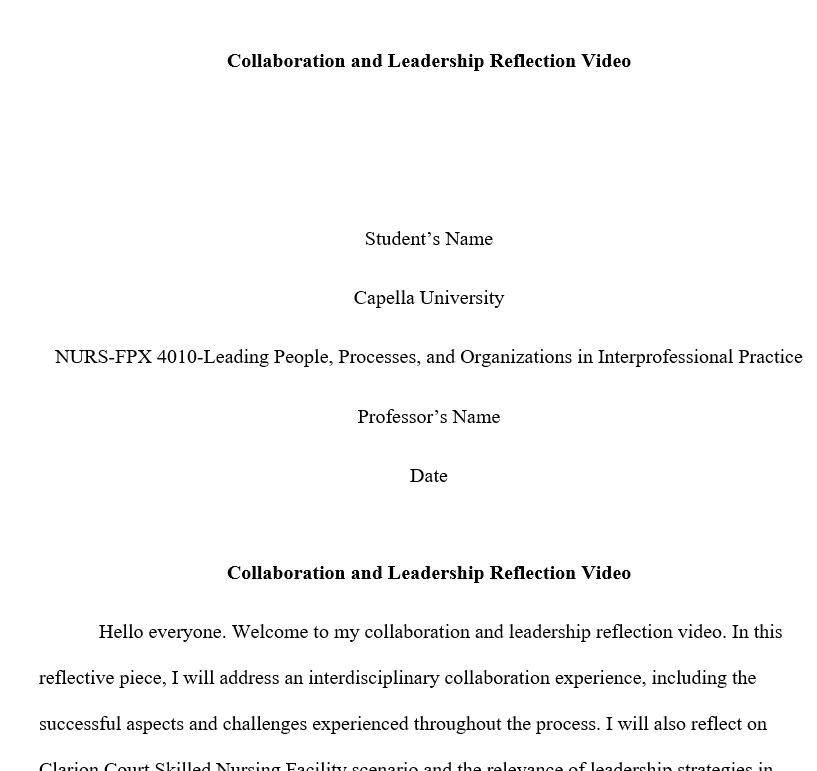NURS-FPX4010_N_Assessment 1-2 Solution.docx
Collaboration and Leadership Reflection Video
Student’s Name
Capella University
NURS-FPX 4010-Leading People, Processes, and Organizations in Interprofessional Practice
Professor’s Name
Date
Collaboration and Leadership Reflection Video
Hello everyone. Welcome to my collaboration and leadership reflection video. In this reflective piece, I will address an interdisciplinary collaboration experience, including the successful aspects and challenges experienced throughout the process. I will also reflect on Clarion Court Skilled Nursing Facility scenario and the relevance of leadership strategies in establishing a functional clinical environment. For my experience, I was part of an interdisciplinary team tasked with the responsibility of sharing insights into the effectiveness of an electronic medical record that was still in the testing stages. The team included physicians, nurses, clinical assistants, the IT team, and the nurse manager.
The IT team asked us to help in identifying limitations of the proposed technology. For instance, I had the chance to contribute ideas about efficiency of the system, the ease of use, and improvement from the previous EMR. The information enabled the IT team to identify improvements, including changes to the hardware and software to enhance reliability and performance. A successful aspect of the collaborative process was the fact that we managed to identify challenges such as the ease of use and shared the findings with the IT team. We also managed to identify resources that would help the nursing team utilize the EMR to optimize care outcomes.
Given the fact that the system would influence safety and quality of patient care across the organization, it was crucial to embrace team-based values, attitudes, and behaviors fit for interdisciplinary collaboration. The process revealed the need for leaders to create an open and transparent environment (Errida & Lotfi, 2021). The effective leadership skills encourage team members to share suggestions about improvements necessary to make the new EMR functional and appropriate for the hospital’s strategic priorities.
However, the busy nature of physicians and a section of the nurses made it challenging to arrange meetings where everyone would have the chance to present their ideas. Another challenge was that the senior members of the team felt that they had the authority to make most of the contributions and influence the direction of the interdisciplinary collaboration. One takeaway from the collaborative experience is that effective leadership is a priority that facilitates proactive participation in addressing issues within the clinical environment.
The leader inspires a shared vision where everyone adopts behaviors and attitudes that match calls for evidence-based and patient-centered practices (Cakiroglu et al., 2021). Another takeaway is about the need for excellent communication to encourage shared decision-making (Nilsen et al., 2020). The process improves information flow due to strong interpersonal relations and individual commitment to making contributions that help the organization move forward. During the meetings, the focus is on aligning actions with patient-centered practices meant to enhance the quality, safety, and quality of care.
Poor collaboration can result in inefficient management of financial and human resources. The weakness undermines the workforce’s ability to perform functions effectively due to ineffective interpersonal relations, low morale and motivation to meet organizational priorities (Stewart, 2018). Similarly, Schot et al. (2020) noted that ineffective collaboration triggers a disengaged and unaccountable workforce and fragmented health care delivery.
The weaknesses cause adverse outcomes such as increased errors, turnover intentions, time wastage, and ineffective information flow across the continuum. The less productive workforce has an adverse implications on efficiencies and effectiveness, which trigger negative financial performance. The poor results highlight the need for health leaders to encourage shared goals and employee engagement as key aspects of a functional hospital.
Strategies for Improving Interdisciplinary Collaboration at Clarion Court Skilled Nursing Facility
Clarion Court Skilled Nursing Facility’s scenario highlights the need for change management driven by functional interdisciplinary collaboration. The right framework entail awareness about a shared vision and the behaviors and value appropriate for making meaningful progress throughout the change process. One viable strategy for the facility involves transformational leadership. The leader uses person-centered approach to create an open, honest, and transparent environment (Asif et al., 2019).
This way, everyone gets the chance to share suggestions about adjustments necessary to achieve the best results. The transformational leader eliminates status quo triggered by power distance and hierarchical barriers (Asif et al., 2019). Schot et al. (2020) urged healthcare providers to have leaders who understand the dynamics and evolution of interdisciplinary collaboration.
The knowledge makes a leader responsive to the demand for strategic communication that matches the needs of individuals with diverse personalities and communication preferences. Excellent communication and information flow are also appropriate to enable leaders to clarify the proposed changes, reasons, and implications on the care team. Further, McNicholas et al. (2019) encouraged leaders to establish and sustain strong interpersonal relations for everyone to understand their roles in the change process and actively share ideas, experiences, and knowledge relevant for improving outcomes.
Change management should also align with guidelines captures in theories such as the Plan-Do-Study-Act (PDSA). The theory allows leaders to clarify action steps and encourage collective buy-in. The positive environment created by leaders empowers team members, closes communication gaps, and enables patient-centered and comprehensive patient care relevant for making meaningful progress towards optimizing care outcomes (Schot et al., 2020).
This way, leaders at Clarion Court Skilled Nursing Facility should develop a comprehensive plan characterized by meetings and briefings that make everyone aware of the proposed changes. A clear explanation of the change guides the care team to transition to the next phases that involve implementing, studying improvements, and using the lessons to adopt EHRs that meet collective aspirations.
As I conclude, it is visible that successful changes depend on leadership traits and qualities. Competent leaders recognize collective buy-in and the need to listen to employees suggestions. The transformational leader is appropriate for successful change management. The leader eliminates status quo, explains proposed changes to the care team, and encourage team-based functions to achieve the best outcomes. Further, the right leaders establish communication pathways to improve information flow across the organization.
References
Asif, M., Jameel, A., Hussain, A., Hwang, J., & Sahito, N. (2019). Linking transformational leadership with nurse-assessed adverse patient outcomes and the quality of care: Assessing the role of job satisfaction and structural empowerment. International Journal of Environmental Research and Public Health, 16(13), 1-13. https://www.ncbi.nlm.nih.gov/pmc/articles/PMC6651060/pdf/ijerph-16-02381.pdf
Cakiroglu, O. C., Hobek, G., & Seren, A.K. (2021). Nurses’ views on change management in health care settings: A qualitative study. Journal of Nursing Management, 30(2), 439-446. https://onlinelibrary.wiley.com/doi/epdf/10.1111/jonm.13500
Errida, A., & Lotfi, B. (2021). The determinants of organizational change management success: Literature review and case study. International Journal of Engineering Business Management, 13, 1-13. https://journals.sagepub.com/doi/epdf/10.1177/18479790211016273
McNicholas, C., Lennox, L., Woodcock, T., Bell, D., & Reed, J. E. (2019). Evolving quality improvement support strategies to improve plan–do–study–act cycle fidelity: A retrospective mixed-methods study. BMJ Quality & Safety, 28(5), 356–365. https://pubmed.ncbi.nlm.nih.gov/30886118/
Nilsen, P., Seing, I., Ericsson, C., Birken, S., & Schildmeijer, K. (2020). Characteristics of successful changes in health care organizations: An interview study with physicians, registered nurses and assistant nurses. BMC Health Services Research, 20(147), 1-8. https://bmchealthservres.biomedcentral.com/articles/10.1186/s12913-020-4999-8
Schot, E., Tummers, L., & Noordegraaf, M. (2020). Working on working together. A systematic review on how healthcare professionals contribute to interprofessional collaboration. Journal of Interprofessional Care, 34(3), 332-340. https://www.tandfonline.com/doi/full/10.1080/13561820.2019.1636007
Stewart, M. A. (2018). Stuck in the middle: The impact of collaborative interprofessional communication on patient expectations. Shoulder Elbow, 10(1), 66-72. https://www.ncbi.nlm.nih.gov/pmc/articles/PMC5734531/

